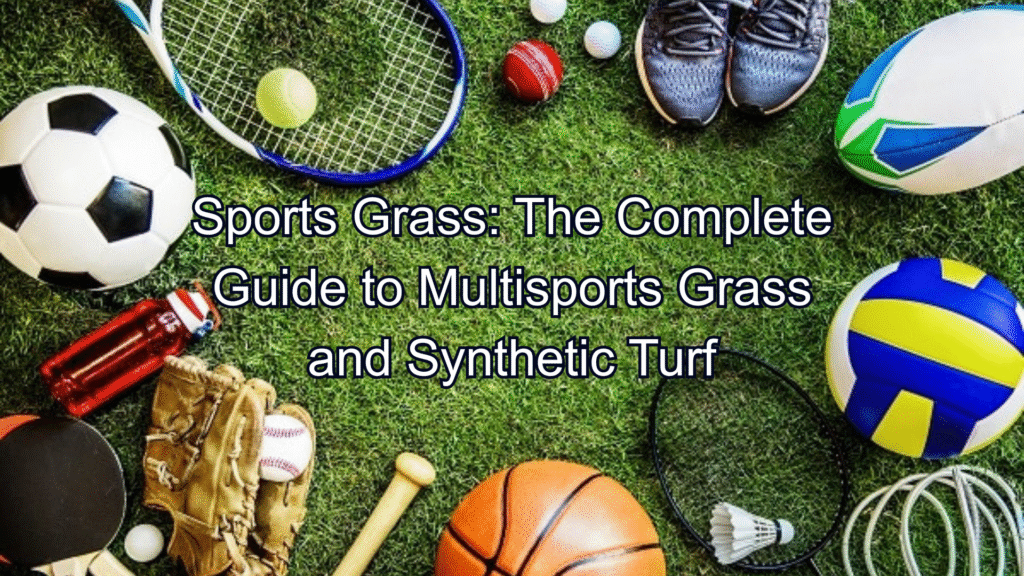- 1. Introduction to Sports Grass
- 2. What Is Sports Grass?
- 3. Benefits of Sports Grass Over Natural Lawns
- 4. Types of Multisports Grass and Synthetic Turf
- 5. Applications of Sports Grass
- 6. Why Choose Synthetic Turf for Sports Fields?
- 7. Features of High-Quality Sport Grass
- 8. Installation Process of Sports Grass
- 9. Maintenance Tips for Multisports Grass
- 10. Cost and Durability Considerations
- 11. Eco-Friendly Aspects of Sports Grass
- 12. Conclusion
- 13. Frequently Asked Question (FAQ'S)
1. Introduction to Sports Grass
Sports surfaces play a vital role in performance, safety, and durability. Over the past few years, sports grass has emerged as a preferred alternative to natural lawns in stadiums, schools, playgrounds, and sports complexes. Modern synthetic turf is designed to replicate the look and feel of real grass while offering superior resilience. From football to tennis, multisports grass provides versatility for different sports. In this guide, we’ll explore everything you need to know about sports grass, its benefits, applications, and maintenance.
2. What Is Sports Grass?
Sports grass, also referred to as sport grass or synthetic turf, is an artificial surface made from advanced synthetic fibers. It is specifically designed to withstand heavy use and provide consistent playing conditions. Unlike natural grass, which can wear out or become patchy, sports grass stays uniform and safe throughout the year.
3. Benefits of Sports Grass Over Natural Lawns
Switching to sports grass has many advantages, especially for large-scale and high-traffic areas:
- All-Weather Playability: No muddy patches or waterlogging.
- Low Maintenance: No mowing, watering, or fertilizing required.
- Durability: Lasts longer under heavy use compared to natural grass.
- Safety: Modern synthetic turf includes shock absorption for reduced injuries.
- Cost-Effective: Lower upkeep costs in the long run.
4. Types of Multisports Grass and Synthetic Turf
Different types of multisports grass are designed to meet specific sporting needs:
- Football Turf: Long-pile synthetic turf with rubber infill for stability and cushioning.
- Cricket Turf: Durable grass carpet with consistent bounce.
- Tennis & Hockey Turf: Shorter pile with smooth surface for speed and accuracy.
- Multisports Grass: Versatile surface designed for multiple sports in schools and community playgrounds.
- Indoor Sport Grass: Used in gyms, training centers, and multipurpose halls.
5. Applications of Sports Grass
Sports grass can be used in a wide variety of environments, including:
- Professional Stadiums: Football, cricket, and rugby fields.
- Schools & Universities: Multipurpose play areas.
- Recreational Parks: Community grounds and public playgrounds.
- Indoor Sports Arenas: Gyms and training centers.
- Commercial Projects: Resorts, clubs, and fitness complexes.
6. Why Choose Synthetic Turf for Sports Fields?
Synthetic turf is specifically engineered to meet the rigorous demands of sports. Unlike natural grass, which deteriorates after continuous play, synthetic turf:
- Provides consistent performance in all weather conditions.
- Resists heavy foot traffic without losing quality.
- Offers enhanced safety features, including shock-absorbing layers.
- Saves time and costs related to maintenance.
This makes synthetic turf a long-term investment for any sports facility.
7. Features of High-Quality Sport Grass
When selecting sport grass, consider the following features:
- UV Resistance: Prevents fading under sunlight.
- Shock Absorption: Reduces risk of injuries.
- Non-Toxic Fibers: Safe for athletes and children.
- Drainage System: Prevents water accumulation.
- Realistic Look and Feel: Closely resembles natural grass.
8. Installation Process of Sports Grass
Installing sports grass involves a few important steps:
- Surface Preparation: Remove existing grass or debris.
- Base Layering: Lay crushed stones or sand for stability.
- Drainage Setup: Install a proper system to avoid waterlogging.
- Rolling Out Synthetic Turf: Spread the turf evenly.
- Seaming & Securing: Join turf pieces with adhesive or seaming tape.
- Infill Application: Use rubber granules or sand for stability and cushioning.
- Final Brushing: Lift fibers to give a natural look.
9. Maintenance Tips for Multisports Grass
Although multisports grass requires less care than natural grass, regular maintenance ensures longevity:
- Brushing: Keeps turf fibers upright.
- Cleaning: Remove debris, litter, and dirt regularly.
- Water Rinsing: Wash away dust and sweat residues.
- Infill Maintenance: Top up rubber or sand infill when needed.
- Inspection: Check for loose seams or worn-out areas.
10. Cost and Durability Considerations
While the initial installation cost of sports grass is higher than natural grass, the long-term savings make it cost-effective. A well-maintained synthetic turf field can last up to 10–12 years, making it a worthwhile investment for schools, stadiums, and clubs.
11. Eco-Friendly Aspects of Sports Grass
Modern synthetic turf is designed with eco-conscious features:
- Saves water compared to natural grass lawns.
- Eliminates the need for chemical fertilizers and pesticides.
- Many sport grass products are made from recyclable materials.
- Reduces maintenance-related carbon emissions.
This makes sports grass an environmentally responsible choice for communities and institutions.
12. Conclusion
Sports grass is revolutionizing how we design and maintain play areas. With durability, safety, and versatility, sport grass and synthetic turf have become the go-to solution for modern sports facilities. Whether you are installing multisports grass in a school or synthetic turf in a stadium, you’ll enjoy long-term benefits in performance and cost savings.
